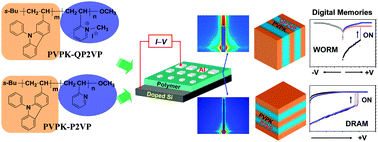Finely tuned digital memory modes and performances in diblock copolymer devices by well-defined lamellar structure formation and orientation control†
Abstract
Block copolymers of poly(2-vinyl-9-phenylcarbazole) (PVPK) and poly(2-vinylpyridine) (P2VP) or quaternized P2VP (QP2VP), including homopolymers, were synthesized by sequential living anionic polymerization and selective post-modification: PVPK–P2VP (43/57 in volume) and PVPK–QP2VP (31/69). All polymers were amorphous and soluble in common solvents. The blocks in the copolymers were found to undergo phase-separation. Nanoscale thin film morphology details were investigated by quantitative synchrotron grazing incidence X-ray scattering (GIXS) analysis. PVPK–QP2VP (31/69) self-assembled as a vertical lamellar structure in the carbon disulfide-annealed films, exhibiting p-type unipolar write-once-read-many-times (WORM) memory behavior. In comparison, PVPK–P2VP (43/57) formed a horizontal lamellar structure in chloroform-annealed films, revealing p-type unipolar dynamic random access memory (DRAM) behavior. Both the memory systems showed very high ON/OFF current ratio, 104–109, depending on the reading voltage. The switching-ON voltage, however, was lower for the PVPK–QP2VP (31/69) film (ca. 4 V) than for the PVPK–P2VP (43/57) (ca. 6 V). Overall, WORM memory and DRAM behaviors were nicely demonstrated with high performances by the development of well-defined lamellar structure in the block copolymer films and their memory modes could be easily tuned from one to another or vice versa by the orientation control of the lamellar structure. Moreover, the excellent memory performance results based on the vertical lamellar structure open up a process feature, that digital memory devices can be significantly improved in terms of their memory capacity by the fabrication of a nanoscale vertical lamellar structure using block copolymers composed of electroactive and dielectric blocks. In addition, memory origins and mechanisms in the block copolymer films were investigated.


 Please wait while we load your content...
Please wait while we load your content...